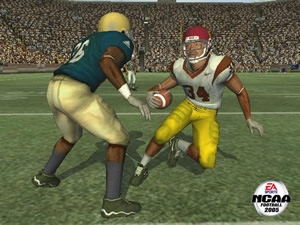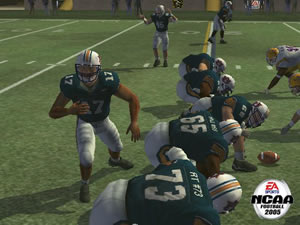Playing to the crowd.
To some, it may come as a surprise that EA’s Tiburon Studios, the developers
of NCAA Football 2005, chose to make so many interesting tweaks
and changes to their game in spite of the fact that their only potential competition,
NCAA Gamebreaker 2005, was cancelled. To me, it’s surprising
that anyone would consider the Gamebreaker series competition
at all, as EA’s series has
totally dominated the college football scene for a few years now. What’s less
surprising is that the tweaks and changes made to NCAA Football
2005 are well-integrated, subtle and effective.
Most of the new features revolve around the crowd’s influence on the game. For
example, if the home team makes a huge play, the crowd goes nuts, which is also
represented as a meter in the upper right-hand corner of the screen.
In turn, changes in the meter affect the composure levels of the players on the
field. If you’re the home team and your crowd is completely
out of the game, your composure will take a hit, making it more likely that you’ll
botch any given play.
Though
the crowd effect sounds intangible, you can actually see its representation on
players via the new Match-up Stick feature. Simply pressing the right stick before
the snap in any of three directions will show how different players match up
against their counterparts. So if you need a yard on fourth down, you can check
your full- and half-back’s composure ratings and then send one of them toward
the line of scrimmage mismatch that favors you most.
If a player’s composure is shaken badly enough, not only will he run the increased
risk of biffing a play, but his overall stats will also decrease until he regains
his composure. As a result, a stud quarterback who gets sacked three times in
a row and then throws four bad passes will lose speed and accuracy until he either
makes some completions, or you manage to quiet the crowd with a great running
play.
In yet another crowd-involved touch, players on the home team can either pump
up the crowd on defense or quiet the crowd down on offense to give themselves
the maximum advantage in terms of crowd influence. When the crowd gets completely
pumped up, the screen will tremble and your opponent’s controller will vibrate
constantly. While the vibrating controller is a good idea, the shaking screen
might make you feel ill. Motion-sickness plus gaming plus lots of salty foods
and caffeine equals a volatile combination.
At any rate, EA has once again successfully introduced a brand new play dynamic
into football gaming, and done it seamlessly and creatively. Very nice.
Dynasty
Mode has seen some changes as well, but they’re not entirely for the better.
The Happiness factor is understated and simple – certain players will
leave if they aren’t
played enough. The Discipline aspect, however, is flat and poorly implemented.
Basically, as each week passes you might get a warning about one of your players
having disciplinary problems. For some reason, you’re
forced to decide whether or not to suspend before finding out who the offending
team member is or what he’s done. As a result, the game can force you to bench
Cal’s Aaron Rodgers for three games due to poor academic performance. Yeah, right.
There’s no way I’m benching my star quarterback for a quarter of the season because
he cut some classes. Hell, I’d do his homework for him if it’d lead to another
bowl win. Alas, once you decide to discipline, it’s out of your hands, turning
the whole system into an annoying spin of the wheel.
 NCAA
NCAA
2005 is complete with all your favorite (Dynasty) and not-so-favorite
(College Classic) modes. Not a lot has changed since last
season, although many
of the cooler features are back, such as the Sports Illustrated covers that
focus on any given week’s big story. There are also a ton of unlockable pennants
that open up new teams and cheats, and you can even create custom signs for fans
to hold up during games.
The biggest new gameplay addition is the ability to over-commit to tackles. By
pressing the appropriate button, you can attempt a savage hit that will potentially
knock a ball loose, or at least diminish the tackled player’s composure level.
There is also a new quick audible option that lets you instantly set a play
to your audible list. Although you won’t want to spend a lot of time on this
(a play clock is a terrible thing to waste), it’s great for picking one running
play, setting its reverse to audible, and then deciding which to run based
on match-ups.
Otherwise, the gameplay is identical to last year’s version. It’s still much easier to run sweeps than it is to run up the middle, especially on draw plays where the passing icons spring up and obscure your view of the play until it’s too late to respond. Oh well, real men pass on every down, anyway.
Though the content is identical throughout the different versions of NCAA
Football 2005, the graphics are not. In an odd switcheroo, the PS2 version is the clear
winner thanks to its rock solid framerate. Everything else has seen minor tweaks
to last year’s game, from the character models and animations to the much improved coaches and cheerleaders. It might not be quite the graphical tour de force that is Madden, but NCAA
Football 2005 is no slouch.
 NCAA Football 2005 sounds better than ever thanks to the emphasis on ambient
NCAA Football 2005 sounds better than ever thanks to the emphasis on ambient
crowd noise. From rally chants to “Boos” of outrage, NCAA
2005 does a great job setting up the right collegiate atmosphere. The ply-by-play team of Brad Nessler, Kirk Herbstreit and Lee Corso is back and have been given loads of new lines. Their commentary seems more adapted to actual in-game and in-season occurrences this year.
Both the Xbox and PS2 versions are playable online, and while Xbox Live! offers
a more robust package than its Sony counterpart, both services offer leader
boards, even team play, and a cool sports ticker that posts the scores of other
ongoing games.
You have to hand it to EA and Tiburon for stepping up their franchise in the
right area. While other games do their damnedest to make first-person football
work, NCAA Football 2005 has changed the playing field by
tying the college atmosphere into the gameplay, leading to a smart, well-designed
sequel.
-
Adds new dimension to genre
-
Solid gameplay
-
Graphically improved
-
Sounds great
-
Lame discipline feature







